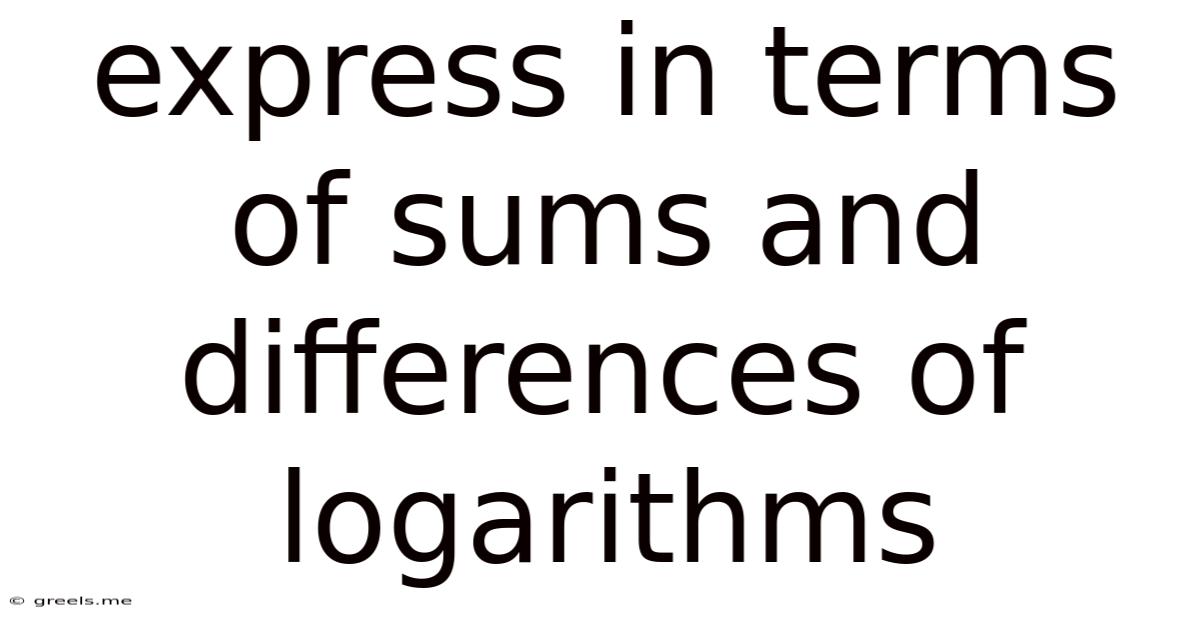Express In Terms Of Sums And Differences Of Logarithms
Greels
Apr 23, 2025 · 5 min read

Table of Contents
Expressing Logarithms as Sums and Differences: A Comprehensive Guide
Logarithms, at first glance, might seem like intimidating mathematical constructs. However, understanding their properties, especially the rules governing their sums and differences, unlocks a powerful tool for simplifying complex expressions and solving intricate equations. This comprehensive guide will delve into the intricacies of expressing logarithms as sums and differences, providing a solid foundation for anyone seeking to master this crucial aspect of mathematics.
The Fundamental Properties: The Building Blocks
Before diving into complex examples, let's solidify our understanding of the fundamental properties that govern logarithmic operations. These properties are the cornerstones upon which all subsequent manipulations are built.
Product Rule: The Sum of Logs
The product rule states that the logarithm of a product is equal to the sum of the logarithms of the individual factors. Mathematically, this is expressed as:
log<sub>b</sub>(xy) = log<sub>b</sub>(x) + log<sub>b</sub>(y)
where 'b' represents the base of the logarithm, and 'x' and 'y' are positive real numbers. This rule significantly simplifies expressions involving the logarithm of a product, transforming it into a more manageable sum of individual logarithms. This is particularly useful when dealing with large numbers or complex expressions, allowing for easier calculation and manipulation.
Quotient Rule: The Difference of Logs
Conversely, the quotient rule dictates that the logarithm of a quotient is equal to the difference of the logarithms of the numerator and the denominator. The formula is:
log<sub>b</sub>(x/y) = log<sub>b</sub>(x) - log<sub>b</sub>(y)
Similar to the product rule, this simplifies expressions involving division. By transforming a logarithmic quotient into a difference, we can often simplify calculations and make the expression more tractable. This is especially beneficial when dealing with fractions or ratios.
Power Rule: Bringing the Exponent Down
The power rule allows us to handle exponents within logarithmic expressions. It states that the logarithm of a number raised to a power is equal to the exponent multiplied by the logarithm of the number:
log<sub>b</sub>(x<sup>n</sup>) = n log<sub>b</sub>(x)
This rule is invaluable in simplifying expressions with exponents, allowing us to move the exponent outside the logarithm, thus simplifying calculations. This is particularly useful in solving equations involving exponential terms.
Change of Base Formula: Adapting to Different Bases
While many logarithmic calculations are done using base 10 or the natural logarithm (base e), sometimes it's necessary to change the base. The change of base formula provides the means to do this:
log<sub>b</sub>(x) = log<sub>a</sub>(x) / log<sub>a</sub>(b)
where 'a' is the new base. This formula proves indispensable when dealing with logarithms of different bases, enabling consistent calculations and comparisons.
Applying the Rules: Examples and Illustrations
Let's put these rules into practice with a series of examples, illustrating their application in simplifying complex logarithmic expressions.
Example 1: Simplifying a Product
Simplify log<sub>10</sub>(100 * 1000).
Using the product rule:
log<sub>10</sub>(100 * 1000) = log<sub>10</sub>(100) + log<sub>10</sub>(1000) = 2 + 3 = 5
Example 2: Simplifying a Quotient
Simplify log<sub>2</sub>(64/8).
Using the quotient rule:
log<sub>2</sub>(64/8) = log<sub>2</sub>(64) - log<sub>2</sub>(8) = 6 - 3 = 3
Example 3: Handling Exponents
Simplify log<sub>3</sub>(27<sup>2</sup>).
Using the power rule:
log<sub>3</sub>(27<sup>2</sup>) = 2 * log<sub>3</sub>(27) = 2 * 3 = 6
Example 4: Combining Multiple Rules
Simplify log<sub>5</sub>[(25 * 125) / 5].
This example requires the application of multiple rules:
log<sub>5</sub>[(25 * 125) / 5] = log<sub>5</sub>(25 * 125) - log<sub>5</sub>(5) = log<sub>5</sub>(25) + log<sub>5</sub>(125) - log<sub>5</sub>(5) = 2 + 3 - 1 = 4
Example 5: Change of Base
Convert log<sub>2</sub>(8) to base 10.
Using the change of base formula:
log<sub>2</sub>(8) = log<sub>10</sub>(8) / log<sub>10</sub>(2) ≈ 0.903 / 0.301 ≈ 3
Advanced Applications and Problem Solving
Beyond the basic examples, the ability to express logarithms as sums and differences proves invaluable in more complex scenarios. Consider the following:
-
Solving Logarithmic Equations: Many logarithmic equations can be simplified and solved by expressing them as sums and differences of logarithms. This often leads to simpler algebraic manipulations.
-
Calculus: In calculus, logarithmic differentiation frequently relies on the rules of sums and differences to simplify the derivatives of complex functions.
-
Data Analysis: In fields like statistics and data analysis, expressing logarithmic transformations of data using sums and differences allows for easier interpretation and manipulation.
-
Computer Science: Logarithmic operations are fundamental in computer science algorithms and data structures. The ability to manipulate logarithms is crucial for analyzing the efficiency and complexity of these algorithms.
Common Mistakes to Avoid
While the rules are straightforward, some common mistakes can hinder progress.
-
Incorrect application of rules: Ensure you apply the rules correctly, especially when dealing with multiple operations simultaneously. Pay close attention to the order of operations.
-
Ignoring the domain: Remember that logarithms are only defined for positive arguments. Always check if the arguments within your logarithmic expressions are positive before applying any rules.
-
Confusing bases: Keep track of the base of the logarithm throughout your calculations. Mixing bases can lead to incorrect results.
Conclusion: Mastering the Art of Logarithmic Manipulation
Expressing logarithms as sums and differences is a fundamental skill in mathematics and numerous related fields. By thoroughly understanding the product, quotient, power, and change of base rules, along with careful application and awareness of potential pitfalls, you gain a powerful tool for simplifying complex expressions, solving equations, and tackling advanced mathematical problems. Practice is key to mastering these techniques; working through various examples and gradually increasing the complexity of the problems will solidify your understanding and build your confidence in manipulating logarithmic expressions effectively. This ability will prove invaluable as you progress in your mathematical studies and applications.
Latest Posts
Related Post
Thank you for visiting our website which covers about Express In Terms Of Sums And Differences Of Logarithms . We hope the information provided has been useful to you. Feel free to contact us if you have any questions or need further assistance. See you next time and don't miss to bookmark.